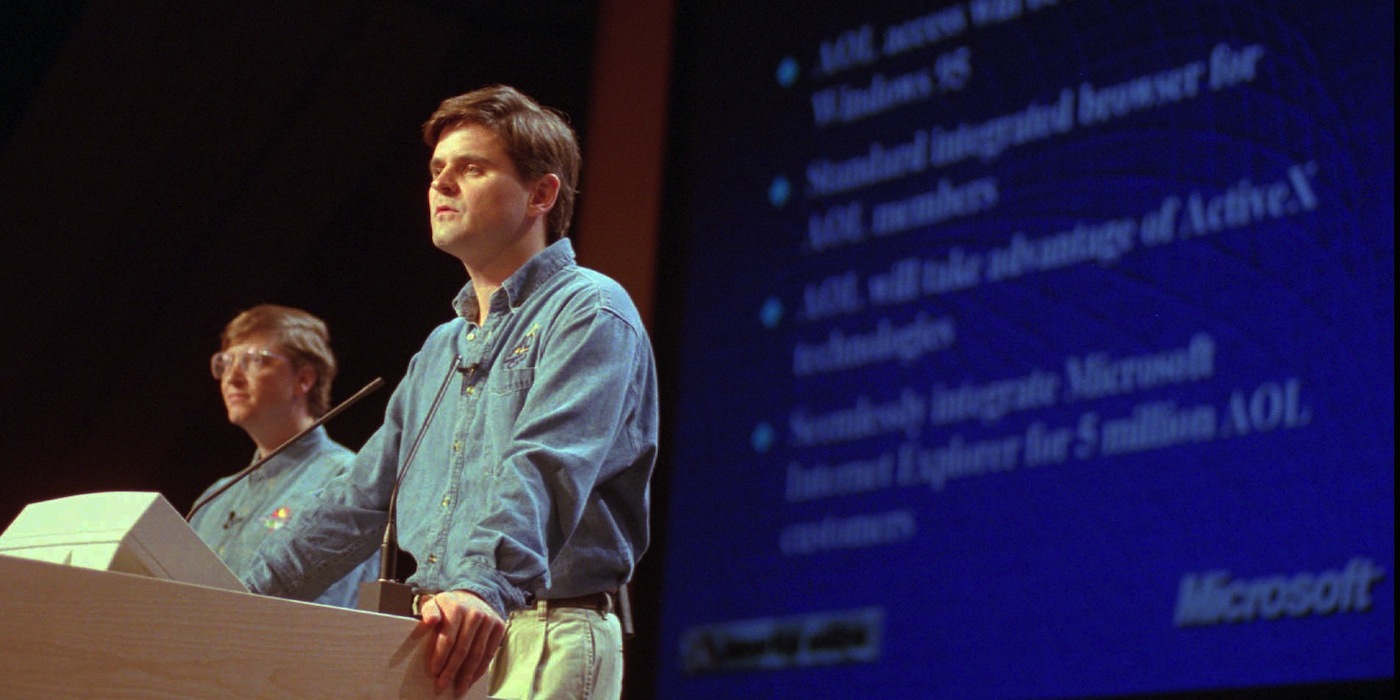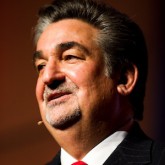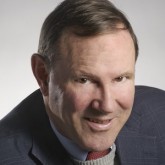Chapter 2
America Goes Online

By 1985, two entrepreneurs, Steve Case and Jim Kimsey, had converted a struggling interactive company called Quantum Computer Services, which had begun under previous management as a dial-up interactive Atari gaming company called Control Video Corp., into something called America Online. It — and for a while its competitors, CompuServe, the Source, Delphi, the Well and Prodigy — would launch the “dial-up” era of so-called “walled garden” proprietary online services, which would explode on to the consumer market and pave the way for much of how news and information services would be distributed and consumed for years to come.
AOL took its stock public in 1992 and over the next few years peppered the country with its free software disks, like some Johnny Appleseed of interactivity. The combination of AOL’s simple, user-friendly interfaces and rapaciously aggressive marketing skills paid off handsomely. The company eventually gathered an audience of more than 30 million paying customers into its “walled garden” — racing from behind to surpass early mover CompuServe, and having a huge impact on how consumers would behave online for years to come. AOL was where many Americans acquired their first screen names and their first email addresses. They had their first “social media” experiences hanging out in AOL chat rooms; they used instant messaging in ways remarkably similar to the early Twitter experience. They even went to the movies and related as Tom Hanks and Meg Ryan hooked up to the sound of that familiar voice then streaming into everyone’s living room with the not-so-subtle reminder of all the excitement that could await you online: “You’ve got mail.” Could it really be Tom or Meg?
For this project, we asked Walter Isaacson, historian, journalist, and president and CEO of the Aspen Institute, to interview Case.
My interest in the space really started a few years before, when I was still in college. I think it was 1979. I read a book by Alvin Toffler called The Third Wave. He was talking about a number of things that were going to happen in the future. But one of them was the idea of an electronic cottage.
Someday, people would be living in this more interactive world, getting information in new ways, communicating with people in new ways. It struck me as an obvious thing that eventually would happen….
How did you see AOL, originally? What exactly was the mission, in terms of forming community, helping with email, delivering content and news?
When we started AOL in 1985, only about three percent of people were online [for about an hour a week]. It really was a pretty niche, almost hobbyist kind of market. Our goal was to expand it and make it much more of a mass market, mainstream phenomenon. Everything we did was geared towards that, trying to make it accessible, easy to use, and more affordable — more useful, more fun, things like that.
Our big bet, even back in 1985, was what we called community. Now people refer to it as social media or other kinds of things, but we thought it was the killer app…. People interacting with people they already knew in new ways that were more convenient, but also people interacting with people they didn’t yet know, but should know, because they had some kind of shared interest.
Even in 1985 we launched things like People Connection or chat rooms, [and] things like instant messaging, buddy lists, and text messaging came out of that. We really always focused on that. It always accounted for the majority of our use. We had a lot of different things as part of AOL, but those community features were the main event in terms of use.
I thought I should hire an investment bank, which I did. My investment banker was Dan Case, who was head of Hambrecht and Quist. Dan worked really closely with us and one day said, “I’ve got a brother who’s just been named head of this little online company, and you talk about stuff the way he’s talking about stuff. He’s seeing the world from one vantage point, you’re seeing it from another, but you’re seeing something very similar. Can I introduce you?” And so I had breakfast with Steve, and over coffee he bought my company.
I remember saying to Steve, “Can we kiss first? I mean, can we date?” He’s like, “Life’s too short to drink bad wine, and this is what we should do. We should merge our companies. You have 150 people. I have 250 people. I’m $40 million in revenues, you’re $20 million. We’ll get scale. There’s not that many people out there that get it.”
What was the idea? Because Steve didn’t like advertising at AOL.
[AOL was predominantly a B-to-B company.] People forget that AOL started as a private network for Commodore, Q Link, and a private network for Apple-AppleLink — and one for IBM. My experience in the sponsored publishing business was similar. Steve brought all of those together, and that’s how America Online was started.
And I get online at 1,200 [baud], but what do I do? We were talking about content and interactive shopping and communications apps.
We were all young, and it was populist. Our message was ease of use and take the drudgery out of your business day.
You would pay AOL $1.35 an hour to be online. We went from 1,200 baud to 9,600 baud, and now you could get a photo delivered. It painted (slowly on the screen). We had our own proprietary thing called Rainman. It would fill up the print, and while you’re reading the print, this photo would, we’d say, “magically appear!” [laughter]
[To Steve Case:] Let me plug the theory that, like Steve Jobs, you believed it had to be really simple, and you had to get people online in an unintimidating way. Those disks and the marketing that would come with Time magazine. You’d say, “Oh, this can’t be that hard. I can put it in and it says ‘You’ve Got Mail.'” Which made it, to me, more distinctive than The Well, Prodigy, CompuServe, which always seemed a bit more intimidating to the average user.
They were more intimidating. We spent a lot of time designing our software and our services to make them as simple as possible. The mantra at the time was, “We want to make this easy enough for my mom to be able to use.” My mom always resented that…. She said, “Why don’t you pick on your Dad?”
But the idea was that we didn’t just want to appeal to technologically sophisticated people. We really wanted everyone to get online. We really wanted to get America online. In order to do that it was going to have to be simple. Some of that was the software. Some of it was things like getting PC manufacturers to bundle the modems in and bundle our software in….
Then we [bundled] our software with magazines and a variety of other products so that no matter where you turned you would see AOL, and it would be coming to you from a trusted, credible endorser, if you will. It might have been IBM bundling us on the computer. It might have been Time magazine bundling our software with their magazine. It was a way to make it easier, but also a way to basically say: “It’s safe to get in the water. It’s time to get online.”
In the process of building its nationwide service, AOL had established a wide network of local dial-up “nodes,” which saved subscribers from having to make long distance toll calls. At the same time, the fledgling service was hungry for content.
We had the idea of, “We have this national network, but we have these local nodes. And what we should do is create affiliates with local companies.” The first company we went to was the Tribune in Chicago, and they embraced us totally.
And invested.
They made an investment that ended up, I think, making them about $4 billion. It was obviously their best investment, but they wanted to learn about digital. They carved out the Chicago territory, so when you logged on to AOL from Chicago it would come up with AOL News, followed by Chicago Tribune news. Then they programmed Chicago Tribune Online. We did the same thing with the [San Jose] Mercury Center, and The New York Times [embraced us].
Where I believe the first generation of journalist/publisher fell down was that they didn’t internalize that this was the birth of a whole new industry. I remember, we’d have our partner conferences, and I would plead with companies. I’d say, “Rolling Stone magazine didn’t create MTV. The New York Times didn’t create CNN. Don’t let that happen to you. Understand the new medium and build new properties, new brands for it. Just taking Time magazine and making it available online isn’t taking advantage of all the things that online is bringing.”
One of the people who first heard AOL pitch its call to digital arms was Tim Landon, then at the Tribune Company, which not only invested early in AOL and made billions on its stock, but also experimented with putting local news content online under its own brand.
A guy showed up on our doorstep [in 1991] and essentially he was trying to reposition his service into an online news information service. The guy was Steve Case. I got involved [because] I had written things…basically saying that these early-stage dial-up proprietary services — Prodigy, CompuServe, Genie — had made a market connection between buyers and sellers, and that that market would displace our classified advertising market. So I was invited into these meetings.
I remember that Steve Case had somehow convinced Apple…to be their proprietary service. I can’t tell you if it was Case’s Procter & Gamble’s marketing skills (or because it was the Apple interface), but my perception, as a young person, was that AOL — which was not AOL at that time but Quantum Computer — was more user friendly than those others. A guy named Mike Silver deserves a lot of credit because we…very quickly invested $5 million in AOL for 10 percent. We private labeled it in Chicago with Chicago Online. From then on, in different variations of my life, I was very focused on, “How do we take the legacy business and the legacy cash flow and redeploy it and create digital assets?”
As you’ve just described, Tribune invested very early in AOL. In ’93, ’94, the web starts going and the Tribune Company, but in particular The Chicago Tribune, is now starting to build websites. Most of what people did in that era was pretty much just simply repurpose the editorial content from the paper and put it online. You guys had the distinct advantage of having a lot of visibility into a service that was succeeding with the consumer. Clearly, they were doing a lot more than publishing newspaper copy into an online service. Did you guys, at that point, think about what AOL was succeeding at doing and triangulate that back to the newspaper?
If you recall, AOL was declared dead a number of times….When the open web was launched, there was a real question by the digital intelligentsia whether AOL would survive. The period you’re talking about, we were wrestling with a number of things at Tribune. One was, “Is AOL just a passing fancy and were things really moving to the web? There was tremendous energy on the editorial side of Tribune to take control of our destiny and not be captive to an AOL environment, but publish on the open web. That was one factor. Another factor was…Ted Leonsis. Ted is a tremendously charismatic and compelling figure.
He was making the pitch [for us to stick with AOL]. He said, “I know AOL is screwed up. We’re an early-stage company. We’re making all sorts of mistakes.” It’s hard to believe this — it shifted very quickly — but at that time in the history of Tribune we’re by far the stronger company and viewed AOL as needing us. We didn’t need them. Ted was saying, “I know you like your newspaper buddies. I know you like fishing and golfing with them. I know I’m kind of fat. But I’m telling you, we’re going to win, and you should do your classified stuff with us. Build these marketplaces with us.”
Just to give you a little color — and I don’t think Ted would mind about this — we’re in those fancy conference rooms, the Colonel’s former office [at Tribune]. The meeting breaks up for a bathroom break. We go outside. Ted pulls me aside and he says, “Look, I’ll give you $5 million right now. Just come with us and build it with us.”
I did not feel that was an appropriate thing, in terms of my fiduciary responsibility. We end up saying, “God, we really like these AOL guys, but it’s so disorganized. It’s chaos. Everybody’s saying it’s going to shift away from AOL. Let’s build it outside of AOL.” That’s why we started Classified Ventures and CareerBuilder. And I really think, on the news side, it was a similar set of discussions.
Eventually we monetized that five- or ten-million-dollar [investment] into two-and-a-half billion dollars. [Authors’ Note: Leonsis says $4 billion.] But it was a hedging strategy….In retrospect, we could have cut a deal there. We could have owned and controlled those channels on AOL. As it played out [from ’94 to ’99], to be able to program a national news channel, a local news channel, the employment channel, the auto channel, the real estate channel on AOL, we would have created a lot of value for Tribune Co. Just one man’s opinion.
The drive to persuade local newspaper companies to come online inside AOL would continue, but as Leonsis recalls, it wasn’t always met with the same enthusiasm as in Chicago.
And then we went to The Washington Post. We said, “It’s such a natural. We’re in D.C.; The Post is in D.C.” At the time there were some people that thought what we were doing was easy. How hard can it be? You buy some computers, you send out some disks, you hire some editors. I remember Steve and I went to a meeting, and it was obvious that they [The Post] couldn’t make that decision. We were driving back and Steve asked me, “So what’s your Plan B?” And I said, “Well, how hard can it be to do what they do? What do they do? They hire some writers. They get a photographer. Why don’t we make a local media product and try it in D.C.? It would at least get their attention, and we’ll learn something.” So we launched AOL D.C. That was the precursor to Digital Cities.
So you were forced into the news business?
Oh, totally.
One of the biggest challenges established media companies faced in moving online wasn’t the problem of finding successful business models, it was the difficulty of creating successful online cultures inside legacy publishing companies. Eventually, they suffered a sort of “Revenge of the Nerds” when it became clear that without hiring and empowering computer scientists in roles of real importance, the legacy media companies couldn’t keep pace with the new all-digital entrants. Despite having passed on a deal with AOL — for content or maybe even something grander like a major investment or acquisition — this lesson of engineering wasn’t lost on Washington Post publisher Don Graham (who, as mentioned, finally threw in the towel in August 2013, selling The Washington Post to Jeff Bezos, no stranger to building and leading engineering cultures).
You would have to look at AOL and say, the lesson of this is not the uses it’s being put to. The lesson of this is that it’s being built by a kind of people we do not have in these walls [at the Post Co.] and we’d better go get some. [Bill] Gates, at that time, was going to everybody’s editorial board and saying, “Good technology people won’t go to work for people like you. Good technology people want to work for Microsoft.” He was wrong. He was wrong. Good technology people want to work on hard problems, and news quickly became a very famous hard problem.


